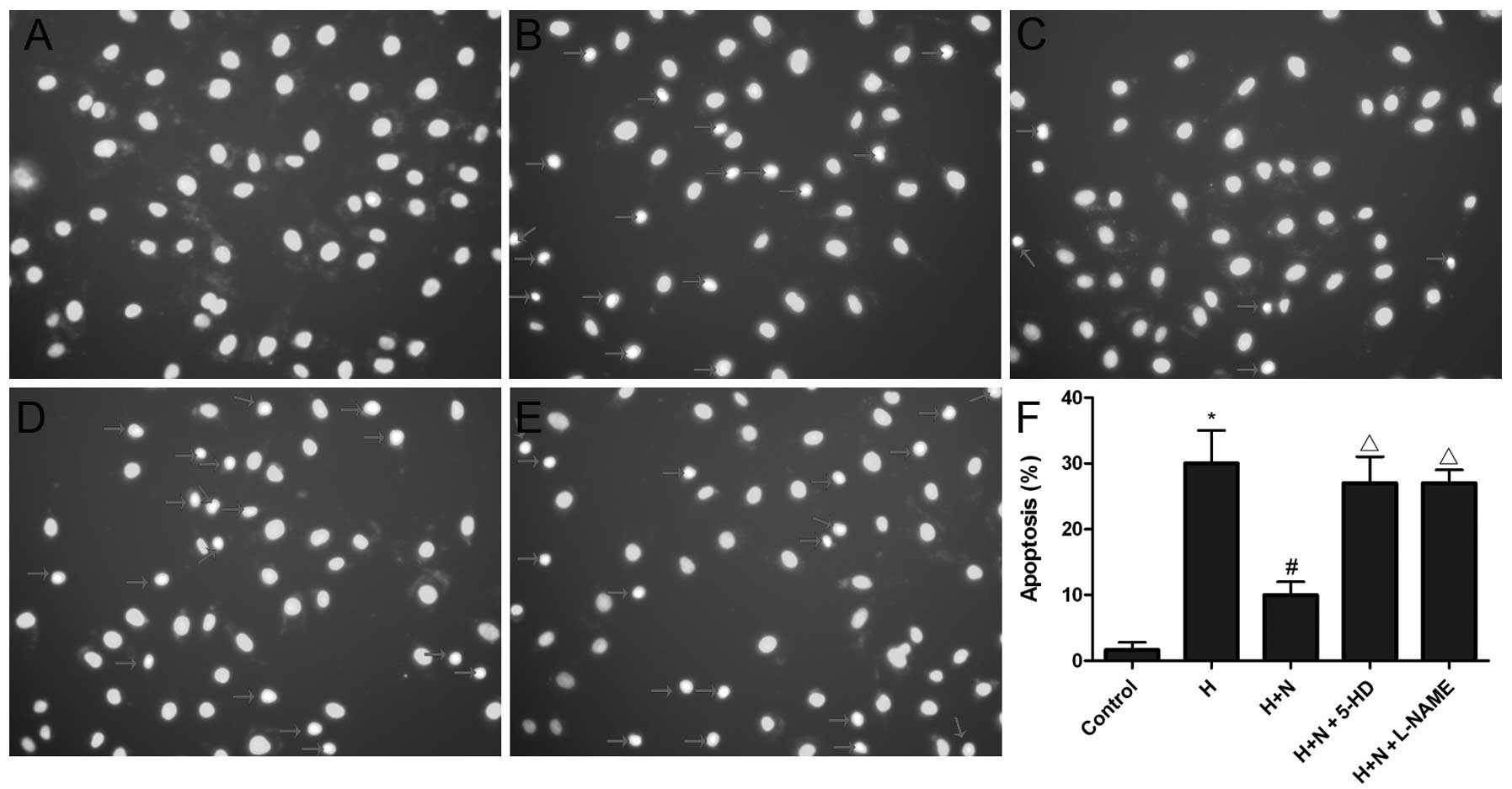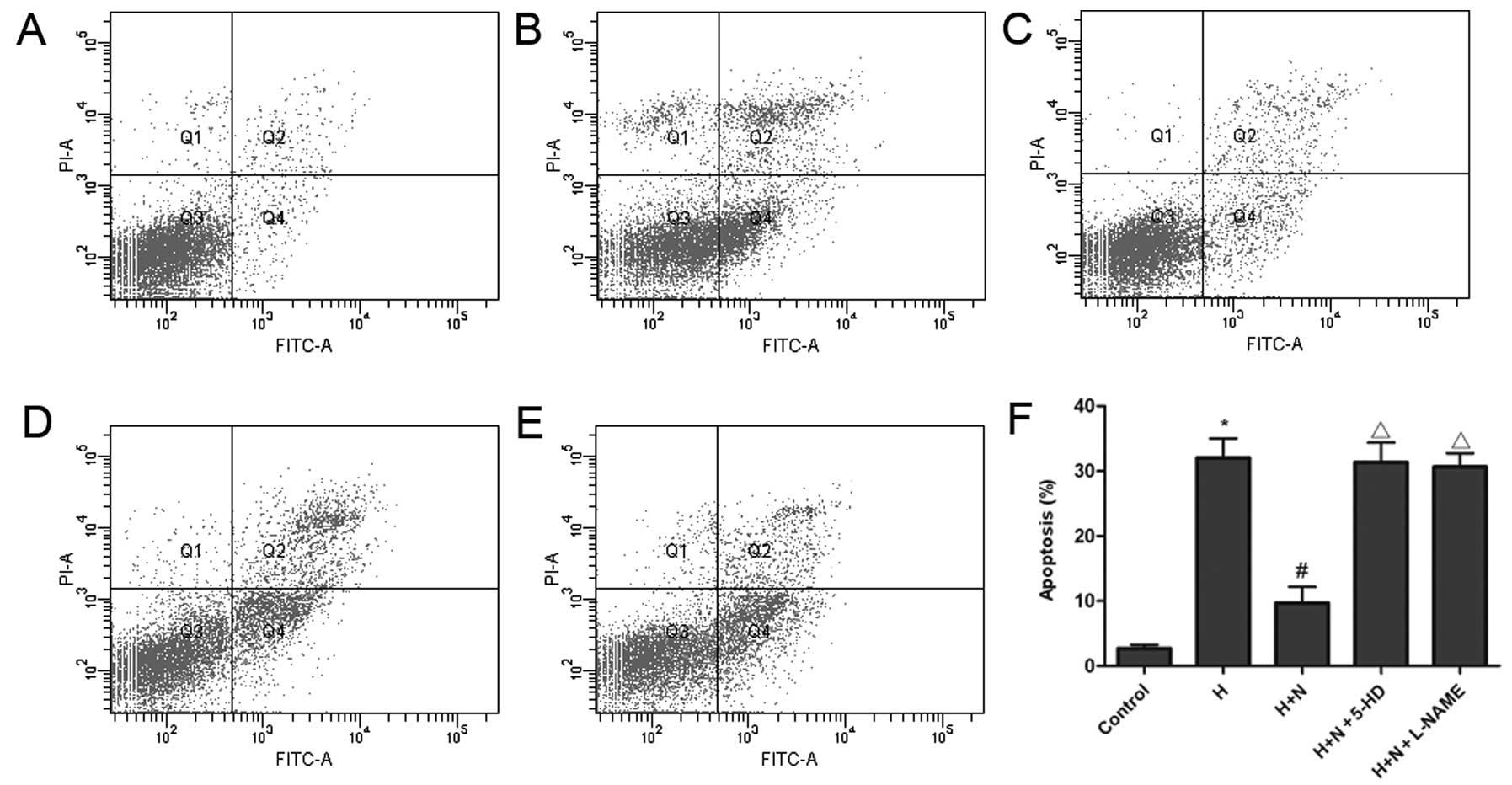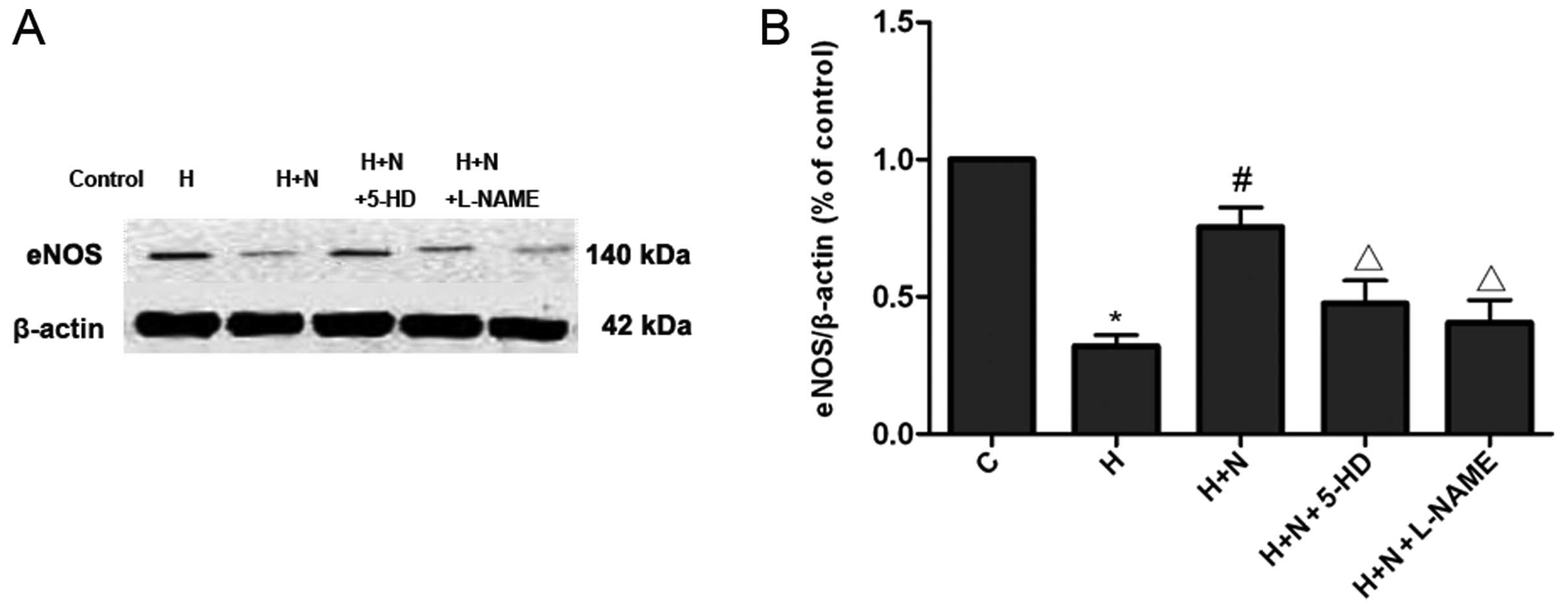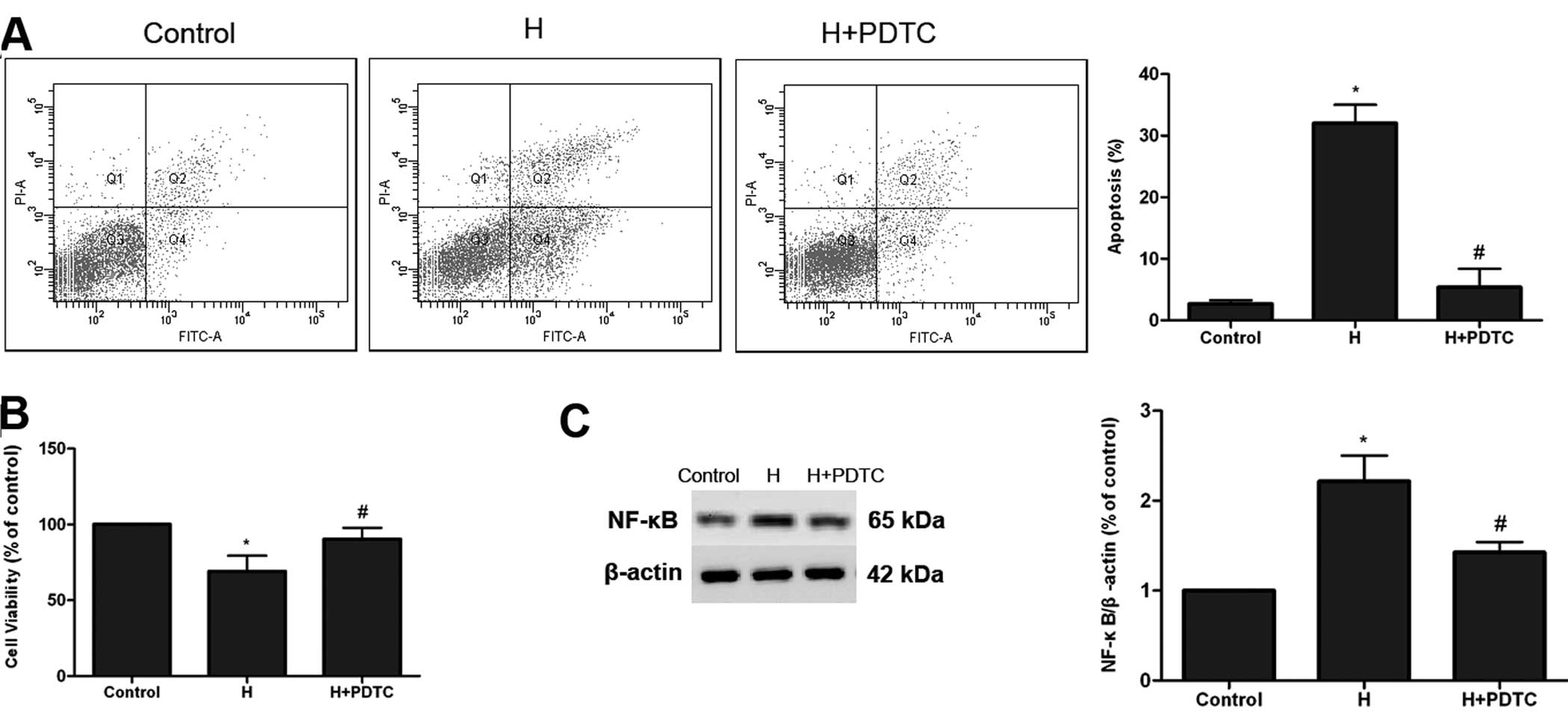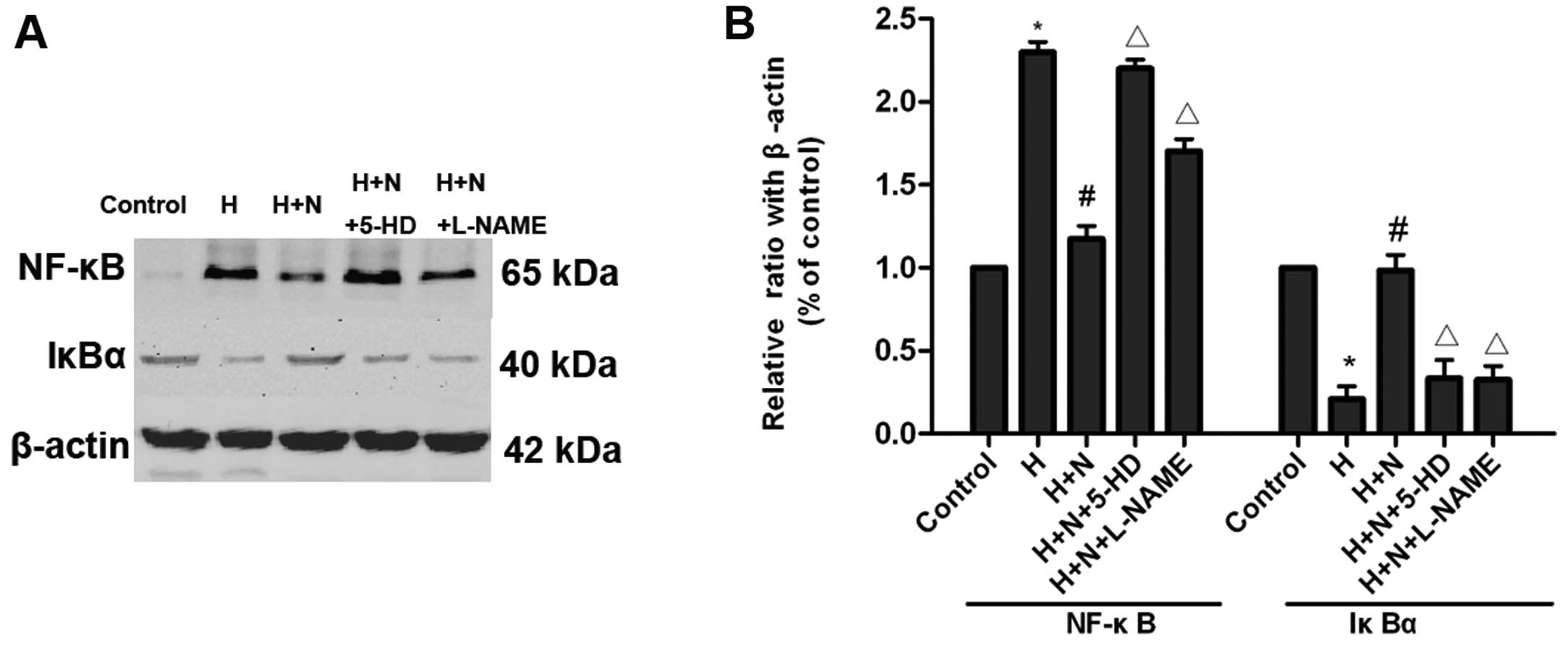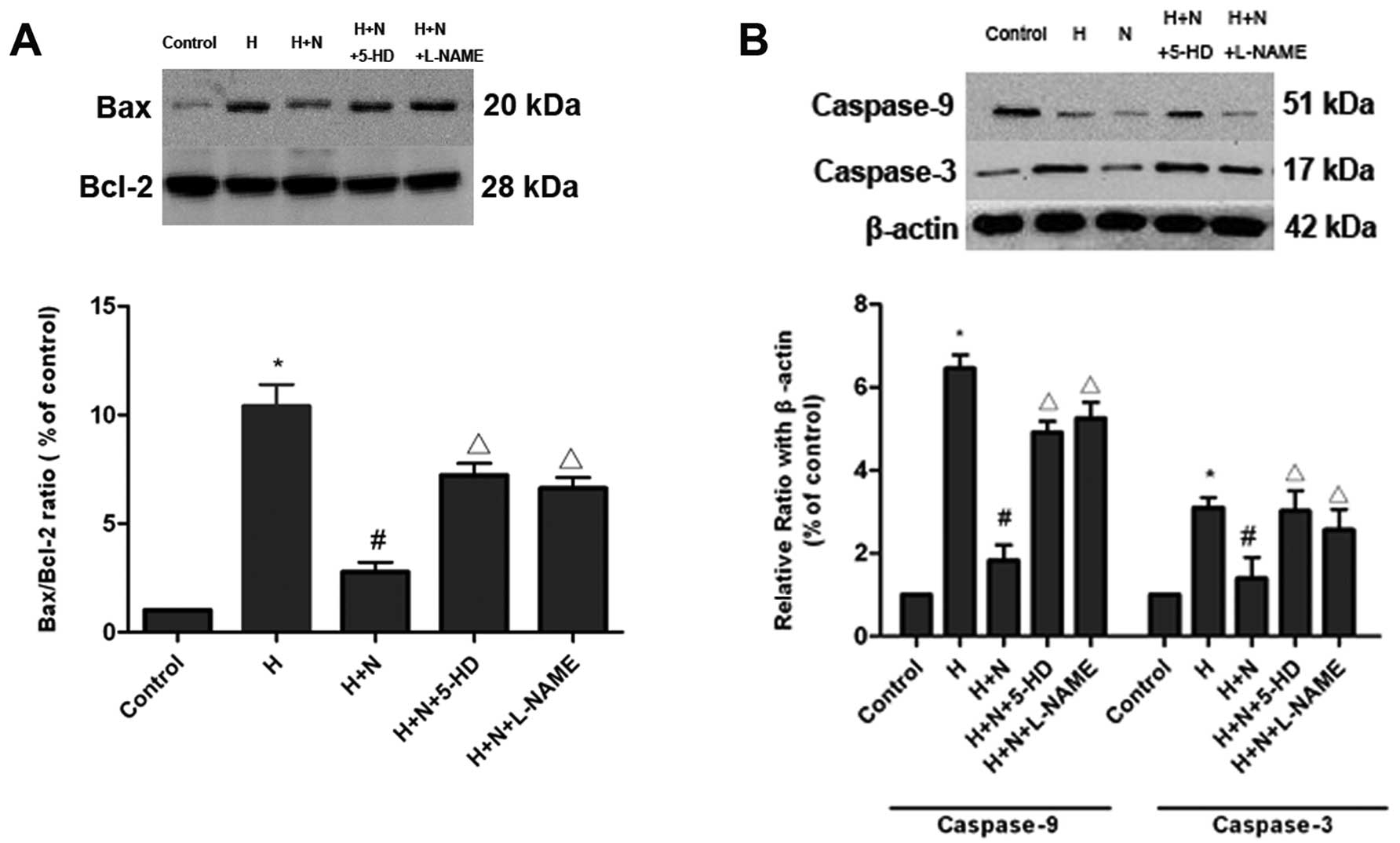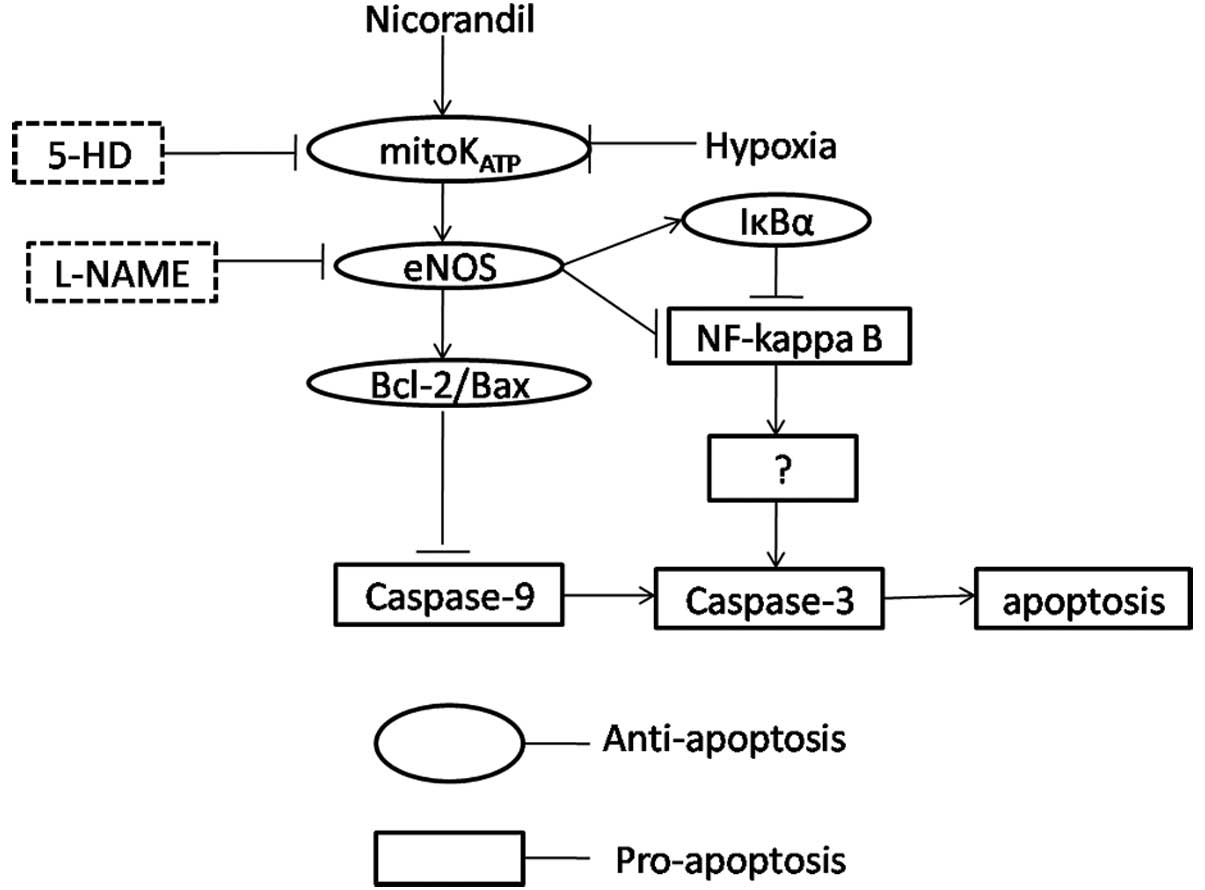Nicorandil inhibits hypoxia-induced apoptosis in human pulmonary artery endothelial cells through activation of mitoKATP and regulation of eNOS and the NF-κB pathway
- Authors:
- Published online on: May 13, 2013 https://doi.org/10.3892/ijmm.2013.1379
- Pages: 187-194
Abstract
Introduction
Pulmonary hypertension (PH) is a progressive disease of various origins that results in right heart dysfunction. In all its variant presentations, this disease is estimated to affect up to 100 million people worldwide, and is associated with a poor prognosis (1). PH can be idiopathic or associated with other diseases, such as connective tissue diseases, congenital heart defects, portal hypertension, left heart disease and chronic obstructive pulmonary disease (COPD), or it can occur after long-term living in plateau environment (1). Although the exact pathogenesis of PH remains unclear, there is increasing support that pulmonary artery endothelial cell (PAEC) apoptosis induced by a variety of factors, including hypoxia, is the initial step and triggering event for PH (2–4). PAEC loss results in an abnormal overgrowth of pulmonary artery smooth muscle cells, provides conditions favoring the emergence of apoptosis-resistant hyperproliferative endothelial cells (ECs), and finally leads to advanced PH (3–5). Current therapies for chronic PH include prostanoids, endothelin receptor antagonists and phosphodiesterase inhibitors; these therapeutic approaches mainly provide symptomatic relief and slow down disease progression (6). There is, therefore, a genuine need for novel treatments that prevent progression of PH by interfering with the pathogenesis of the disease at the initial stage. To this end, antagonism of human PAEC (HPAEC) apoptosis may be a useful approach on which to base novel treatments for PH.
Nicorandil, which is generally used for the management of angina pectoris, has a unique pharmacological profile that includes a nitrate-like effect to dilate peripheral coronary arteries, and an action as an agonist at mitochondrial adenosine triphosphate-sensitive potassium (mitoKATP) channels. In some cell types, nicorandil has been shown to inhibit apoptosis induced by a number of factors, through activation of mitoKATP channels (7–12). However, whether nicorandil has an anti-apoptotic effect in HPAECs remains unknown.
Emerging evidence has indicated an important role for endothelial nitric oxide synthase (eNOS) in the regulation of EC apoptosis. Reduced expression of eNOS leads to a decreased NO synthesis which is a primary factor in the pathophysiology of PH (13). In monocrotaline (MCT)-induced PH rats, nicorandil has been reported to exert a beneficial effect through an increase in eNOS expression in heart and lung tissue (14,15). Furthermore, some studies have found that the opening of mitoKATP channels could induce eNOS expression (16,17). However, it is currently unclear whether nicorandil has the ability to enhance eNOS expression via activation of mitoKATP channels in HPAECs.
Nuclear factor-κB (NF-κB) is a transcription factor that plays an important role in the regulation of the inflammatory response and apoptosis in several cells types (18). Recent studies have observed an increased expression of NF-κB in PH, and have shown that blockade of NF-κB activity could reduce the development of PH (19–21). Of note, nicorandil has been reported to reduce myocardial reperfusion injury by attenuating NF-κB activation (22), and levosimendan, a KATP channel opener, has been found to inhibit NF-κB expression in human umbilical vein endothelial cells (HUVECs) (23). However, little data exists concerning the effect of nicorandil on the NF-κB pathway in HPAECs. Furthermore, although there is accumulating evidence that eNOS or NO can mediate inhibition of NF-κB signaling and suppress NF-κB-dependent apoptosis and inflammation (24–26), little is known about the relationship between eNOS and NF-κB in HPAECs.
The aim of the present study was to determine whether treatment with nicorandil attenuates apoptosis of HPAECs exposed to hypoxia, and, if so, to investigate the mechanisms involved.
Materials and methods
Reagents
Nicorandil was purchased from Tokyo Chemical Industry Co., Ltd. (Tokyo, Japan). Endothelial Cell Medium (ECM), vascular endothelial growth factor (VEGF), fetal bovine serum (FBS), penicillin and streptomycin were obtained from HyClone Laboratories, Inc. (Logan, UT, USA). Antibodies against Bax, Bcl-2, caspase-3 and -9, eNOS, NF-κB and IκBα were purchased from Cell Signaling Technology (Beverly, MA, USA), and antibody against β-actin was purchased from Santa Cruz Biotechnology, Inc. (Santa Cruz, CA, USA). 5-Hydroxydecanoate (5-HD), NG-nitro-L-arginine methyl ester (L-NAME) and pyrrolidine dithiocarbamate (PDTC) were purchased from Sigma (St. Louis, MO, USA). 3-(4,5-dimethylthiazol-2-yl)-2,5-diphenyltetrazolium bromide (MTT), Hoechst 33342, Annexin V-fluorescein isothiocyanate (FITC) and propidium iodide (PI) were obtained from Sigma. AnaeroPack-Anaero was purchased from Mitsubishi Gas Chemical Co. (Tokyo, Japan). All other chemicals were of the highest purity available commercially.
Cell culture and treatment
HPAECs were obtained from ScienCell Research Laboratories (San Diego, CA, USA). HPAECs (1×105/75 cm2 flask) were seeded in ECM containing 10% (v/v) FBS, 1% (v/v) VEGF, 100 U/ml penicillin and 100 U/ml streptomycin, at 37°C in a 5% CO2-humidified atmosphere. The culture medium was replaced every 2–3 days until 80–90% confluence was achieved. HPAECs of the 3rd to 5th passages, in an actively growing condition, were used for the experiments. HPAECs were divided into 6 treatment groups: i) control group: cells were cultured under normoxic conditions for 24 h (20% O2, 5% CO2); ii) hypoxia group: cells were cultured in the hypoxic chamber using AnaeroPack-Anaero, a disposable oxygen-absorbing and CO2-generating agent, for 24 h; iii) hypoxia + nicorandil group: cells were pretreated with nicorandil (100 μM), and then cultured in the hypoxic chamber using AnaeroPack-Anaero for 24 h; iv) hypoxia + nicorandil + 5-HD group: cells were pretreated with nicorandil (100 μM) and 5-HD (500 μM), and then cultured in the hypoxic chamber using AnaeroPack-Anaero for 24 h; v) hypoxia + nicorandil + L-NAME group: cells were pretreated with nicorandil (100 μM) and L-NAME (300 μM), and then cultured in the hypoxic chamber using AnaeroPack-Anaero for 24 h; vi) hypoxia + PDTC group: cells were pretreated with PDTC (10 μM), and then cultured in the hypoxic chamber using AnaeroPack-Anaero for 24 h. The concentrations of nicorandil, 5-HD, PDTC and L-NAME used in this study were selected on the basis of previously published studies (8,27,28). 5-HD, L-NAME and PDTC were added to the medium 30 min prior to the addition of nicorandil. The AnaeroPack started to absorb oxygen within 1 min, oxygen tension inside the box dropped to 1 mmHg within 1 h (O2 <1%, CO2 ~5%).
MTT cell viability assay
Cell viability was determined by MTT incorporation. HPAECs were seeded in 96-well culture plates, cultivated, and divided into different treatment groups as described above. Following addition of the appropriate drugs, 20 μl assay medium containing 5 mg/ml MTT was added to each well before the culture was terminated. After 4 h of incubation at 37°C, the medium was aspirated and the cells were lysed by the addition of 100 μl DMSO. Following a 10-min incubation at 37°C, the optical density of each sample was measured in an ELISA microplate reader using test and reference wavelengths of 570 nm.
Hoechst 33342 staining assay
HPAECs were seeded in 24-well culture plates, cultivated, and divided into different treatment groups as described above. After the addition of appropriate drugs, cells were washed twice with PBS and treated with 100 μl Hoechst 33342 (10 μg/ml) for 15 min at 37°C, in the dark. The medium was aspirated and samples were then analyzed by an Olympus fluorescence microscopy using an excitation wavelength of 346 nm and an emission wavelength of 460 nm.
Annexin V-PI analysis by flow cytometry
Following exposure to the appropriate drugs, cells in the various treatment groups were harvested and resuspended in PBS at a density of 1×106 cells/ml. Following centrifugation at 1,000 × g for 5 min, 195 μl FITC-conjugated Annexin V binding buffer and 5 μl Annexin V-FITC were added. Following gentle vortexing, the mixture was incubated for 15 min at room temperature, in the dark. Following centrifugation at 1,000 × g for 5 min, the medium was aspirated and 190 μl FITC-conjugated Annexin V binding buffer and 10 μl PI were added. Immediately after gentle vortexing, the sample was analyzed by flow cytometry. Early apoptotic cells were characterized by high Annexin V binding and low PI staining, whereas late apoptotic and necrotic cells stained strongly with both Annexin V and PI.
Western blot analysis
Cells were lysed in iced lysis buffer (97.9% RIPA, 1% PMSF, 1% phosphatase inhibitors and 0.1% protease inhibitors). Total protein (50 μg/lane) was separated by SDS-PAGE and transferred to a PVDF membrane (Millipore, Billerica, MA, USA). Following incubation in blocking solution (5% nonfat milk), membranes were incubated overnight at 4°C with primary antibodies against Bax, Bcl-2, caspase-3 and -9, eNOS, NF-κB, IκBα or β-actin. Membranes were then washed. β-actin was detected directly with enhanced chemiluminescence reagents. The other proteins of interest were detected with enhanced chemiluminescence reagents following incubation with horseradish peroxidase-conjugated secondary antibody (1:8,000 dilution) for 1 h. The relative density of each protein band was normalized to that of β-actin. All results were representative of at least three independent experiments.
Statistical analysis
Data are presented as the means ± SD, derived from at least three independent experiments. Statistical significance between groups was analyzed by one-way ANOVA followed by Tukey or Dunnett’s T3 test, as appropriate, using SPSS 15.0 software. A value of P<0.05 was considered to indicate statistically significant differences.
Results
Effect of nicorandil on hypoxia-induced loss of HPAEC viability
To determine whether hypoxia can reduce HPAEC viability, HPAECs were cultured under hypoxic conditions for 0, 6, 12, 24 or 36 h, and cell viability was analyzed using MTT. HPAEC viability following hypoxia for 6 or 12 h was not significantly different (P>0.05) to that of control cells not exposed to hypoxia (Fig. 1A). However, hypoxia for 24 or 36 h decreased HPAEC viability to 67.5±3.5 and 36.7±2.1%, respectively, of the control group (P<0.05) (Fig. 1A). Based on these data, subsequent experiments were carried out using hypoxia for 24 h, unless otherwise stated. Three different concentrations (100, 500 and 1,000 μM) of nicorandil improved cell viability. Nicorandil (100 μM) itself did not have a significant effect on cell viability (Fig. 1B). However, the protective effects of nicorandil against hypoxia-induced decreases in cell viability were blunted by 5-HD or L-NAME (Fig. 1C); under hypoxic conditions, the reduction in cell viability in the presence of 5-HD or L-NAME (combined with nicorandil) was significantly greater (P<0.05) than that in their absence (i.e., nicorandil alone). In addition, nicorandil, 5-HD or L-NAME alone was without effect on HPAEC viability under normoxic conditions (data not shown). These results demonstrated that nicorandil was able to protect HPAECs against decreased cell viability induced by hypoxia, whereas 5-HD or L-NAME was found to inhibit these beneficial effects of nicorandil.
Effect of nicorandil on hypoxia-induced apoptosis of HPAECs
To investigate whether the protective effect of nicorandil on hypoxia-induced cytotoxicity may be due to the attenuation of hypoxia-induced apoptosis, HPAEC apoptosis was determined using a Hoechst 33342 staining assay and flow cytometry.
The Hoechst 33342 staining assay demonstrated that exposure to hypoxia for 24 h increased the apoptotic ratio of cells, which showed a profile of cell shrinkage, chromatin condensation and fragmented fluorescent nuclei (Fig. 2). The number of Hoechst 33342-positive cells and the apoptotic ratio were significantly reduced by nicorandil (Fig. 2). However, the protective effects of nicorandil against hypoxia-induced cell apoptosis were blunted by 5-HD or L-NAME, as shown by the increase in the number of Hoechst 33342-positive cells and in the apoptotic ratio in the presence of 5-HD or L-NAME, compared with the hypoxia + nicorandil group (Fig. 2).
These findings were supported by the results of experiments using Annexin V and PI, analyzed by flow cytometry. Exposure to hypoxia for 24 h induced a significant increase in the number of apoptotic cells, as identified by flow cytometry, compared with normoxic culture (Fig. 3). Nicorandil markedly promoted cell survival. However, pretreatment with 5-HD or L-NAME abolished the anti-apoptotic effect of nicorandil in cultured HPAECs exposed to hypoxia.
Effect of nicorandil on activation of eNOS
To further investigate the mechanism underlying the anti-apoptotic effect of nicorandil, we examined eNOS protein expression in the various treatment groups by western blot analysis. Hypoxia decreased the expression of eNOS protein, compared with the control group, whereas nicorandil markedly increased the expression of eNOS compared with the hypoxia group (Fig. 4). However, the effects of nicorandil to enhance eNOS expression were suppressed by 5-HD or L-NAME (Fig. 4). By contrast, nicorandil, 5-HD and L-NAME alone had no influence on eNOS expression in HPAECs under normoxic conditions (data not shown).
Effect of nicorandil on inhibition of the NF-κB pathway
As NF-κB plays an important role in the regulation of cell death in some cell types, we examined its effects on hypoxia-induced HPAEC apoptosis. Hypoxia was found to increase expression of NF-κB protein compared to the control group (Fig. 5C), whereas pretreatment with PDTC markedly downregulated the expression of NF-κB (Fig. 5C), inhibited hypoxia-induced cell apoptosis (Fig. 5A) and restored decreased HPAEC viability (Fig. 5B). By contrast, PDTC alone had no influence on HPAEC apoptosis and viability under normoxic conditions (data not shown). We next examined the effect of nicorandil on the regulation of the expression of NF-κB and IκBα (a protein that inhibits NF-κB), and found that nicorandil markedly decreased the expression of NF-κB and increased the expression of IκBα, compared with the hypoxia group. However, these effects of nicorandil were reduced by 5-HD or L-NAME (Fig. 6).
Effect of nicorandil on caspase-3 and -9 protein expression, and the Bax/Bcl-2 protein expression ratio
To explore the potential apoptotic signals involved in the protective effect of nicorandil on hypoxia-induced cell death, we examined protein expression levels of Bax, Bcl-2, caspase-3 and -9 in the various treatment groups, using western blot analysis. Hypoxia increased the Bax/Bcl-2 protein expression ratio, as well as caspase-3 and -9 protein levels, compared with the control group (Fig. 7). Nicorandil markedly decreased the Bax/Bcl-2 protein expression ratio as well as caspase-3 and -9 protein expression, compared with the hypoxia group (Fig. 7). However, these effects of nicorandil were reduced by 5-HD or L-NAME (Fig. 7).
Discussion
There are two major findings in the present study that expand our understanding of the mechanisms of action of nicorandil in HPAECs. First, we found that nicorandil protected HPAECs from hypoxia-induced apoptosis. Second, we demonstrated that the anti-apoptotic effect of nicorandil was through activation of mitoKATP channels and increased eNOS expression, with subsequent inhibition of the NF-κB pathway and the mitochondrial apoptotic pathway.
HPAEC apoptosis has been proposed to be the initial step and the triggering event for PH, including hypoxic PH (HPH) (2–4), and chronic hypoxia is known to be an important cause of EC apoptosis. Date et al (8) showed that nicorandil could inhibit serum starvation-induced apoptosis in vascular endothelial cells through activation of mitoKATP channels, and a similar result was found in oxidative stress-induced apoptosis in neurons (9). In the present study, we demonstrated that nicorandil markedly inhibited the decreased HPAEC viability and increased HPAEC apoptosis induced by hypoxia. However, this beneficial effect of nicorandil was almost completely suppressed by pretreatment with 5-HD, a mitoKATP channel inhibitor, indicating that the effect of nicorandil on HPAECs is mediated via activation of mitoKATP channels.
eNOS, an important enzyme in the production of NO, is present in vascular endothelial cells, and a decreased expression level or abnormality of eNOS protein has been shown to cause EC apoptosis in the early stage of PH (including HPH), leading to the development of PH (13,29–31). For example, mutant mice lacking the eNOS gene, or newborn lambs treated with an eNOS inhibitor, were found to develop progressive elevation of pulmonary arterial pressure and resistance (30,31), and individuals with PH have been shown to have reduced levels of pulmonary arterial eNOS expression (13). Hongo et al (14) reported that, in an MCT-induced PH model, nicorandil was able to protect endothelial function and enhance eNOS expression, and a similar result was found in cardiac tissue (15). Furthermore, Grossini et al (16) showed that opening mitoKATP channels could induce eNOS expression through Akt, ERK and p38 activation, and Roth et al (17) observed that ischemic preconditioning could open mitoKATP channels and subsequently activate eNOS. In our study, we found that pretreatment with nicorandil could restore decreased expression of eNOS induced by hypoxia in HPAECs, while this effect could be inhibited by 5-HD and L-NAME, an eNOS inhibitor, indicating that the effect of nicorandil to enhance eNOS expression was via activation of mitoKATP.
NF-κB can be activated in a variety of cells in response to various factors, and can thereby regulate cell apoptosis (27,32,33). IκBα is the inhibitory protein of NF-κB, and degradation of IκBα results in NF-κB activation. Matsushita et al (32) showed that hypoxia-induced endothelial apoptosis was through NF-κB-mediated Bcl-2 suppression. Similarly, Chen et al (33) reported that HUVECs treated with intermittent high glucose showed activation of the NF-κB pathway, which inhibited cell proliferation and induced cell apoptosis. Furthermore, Huang et al (34) found that NF-κB played a pivotal role in disrupting PAEC membrane integrity in an MCT-induced PH model. Our present study is consistent with previous studies in showing that hypoxia upregulated the expression of NF-κB protein and increased apoptosis of HPAECs, while PDTC, an inhibitor of NF-κB, significantly reduced the enhanced apoptosis of HPAECs and the increased expression of NF-κB. There have also been some reports of an interaction between NF-κB and mitoKATP channels. For example, Kawamura et al (22) reported that nicorandil could attenuate NF-κB activation via opening of mitoKATP channels, and thereby reduce myocar-dial reperfusion injury. In addition, Revermann et al (23) demonstrated that activation of KATP channels could inhibit NF-κB expression in HUVECs. However, whether nicorandil could inhibit the NF-κB pathway via activation of mitoKATP was previously unknown. Our data indicated that nicorandil markedly decreased the protein expression of NF-κB, while increasing the expression of IκBα in HPAECs, and that this effect was diminished by 5-HD. This, therefore, provides the first evidence that nicorandil can inhibit the NF-κB pathway in HPAECs via activation of mitoKATP.
We therefore further explored the link between eNOS and NF-κB. A study on HPAECs found that NO could inhibit hyperoxia-induced NF-κB activation (25). Moreover, Greco et al (35) reported that inhibiting the expression of eNOS was associated with enhanced NF-κB activation and a significant increase in infarct volume in a cerebral ischemia/ reperfusion rat model. A recent study reported that elevated cardiac NO levels following eNOS gene transfer in mice led to a decrease in nuclear translocation of NF-κB in a model of myocardial ischemia (24). Our study is the first to show that the effects of nicorandil to inhibit the NF-κB pathway could be diminished by L-NAME in HPAECs, indicating a relationship between eNOS and NF-κB in these cells, such that upregulation of eNOS expression could inhibit the NF-κB pathway.
The apoptotic signals involved in the protective effect of nicorandil on hypoxia-induced HPAEC death were also investigated in our study. We had already shown that nicorandil could act as a mitoKATP channel opener of HPAECs induced by hypoxia; this result indicated that nicorandil may exert an influence on the mitochondrial apoptotic pathway. There are at least two broad pathways that lead to apoptosis, an ‘extrinsic’ and an ‘intrinsic’ pathway, with apoptosis in mitochondria being the best known intrinsic apoptotic pathway. Several different causes, including hypoxia, reduce the expression ratio of Bcl-2/Bax (which is an important sign of mitochondrial cell apoptosis), leading to the loss of mitochondrial inner membrane potential (Δψm) and the triggering of a release of mitochondrial cytochrome c into the cytosol. There is also activation and upregulation of caspase-9 and -3, and eventually induction of cell apoptosis. Opening mitoKATP channels can increase Δψm (36), maintain the expression ratio of Bcl-2/Bax (11) and inhibit cell apoptosis. In the present study, we found that nicorandil could inhibit the increased Bax/Bcl-2 expression ratio, and the enhanced caspase-3 and -9 expression, induced by hypoxia in HPAECs. This effect of nicorandil could be diminished both by 5-HD and L-NAME, indicating that the anti-apoptotic effect of nicorandil was through inhibition of the mitochondrial apoptotic pathway, and that this action involved an increase in the expression of eNOS via activation of the mitoKATP channel.
There are some limitations to the present study. First, whether it is nicorandil’s action as an NO donor that is involved in the protection of HPAECs against apoptosis remains unknown. In the current study, the protective effect of nicorandil could be almost completely inhibited by 5-HD. Furthermore, Harada et al (37) showed that nicorandil, acting as an NO donor, stimulated PKC-δ and then opened mitoKATP channels. This leads us to the hypothesis that the nitrate-like effect of nicorandil is indeed involved in the protection against HPAEC apoptosis, although opening of the mitoKATP channel also contributes to it. Second, our study has shown that eNOS could mediate enhanced expression of NF-κB protein; however, whether there is feedback between eNOS and NF-κB is not known, and further studies are required to clearly define the relationship between eNOS and NF-κB.
In summary, the present study shows a working hypothesis that nicorandil suppresses hypoxia-induced apoptosis of cultured HPAECs through activation of mitoKATP and increased eNOS expression, which subsequently acts to inhibit the NF-κB pathway and the mitochondrial apoptotic pathway (Fig. 8). This provides strong evidence that nicorandil may be useful as an alternative drug for the treatment of HPH.
Acknowledgements
This study was supported by grants from the National Natural Science Foundation of China (nos. 81273571 and 81200159), the National Major Scientific and Technological Special Project for ‘Significant New Drugs Development’ (2011ZX09302-003-02), the Jiangsu Province Major Scientific and Technological Special Project (BM2011017), and the Open Project Program of the key discipline of the Public Health Department of Jiangsu Province (no. XK13_200902).
References
|
Simonneau G, Robbins IM, Beghetti M, et al: Updated clinical classification of pulmonary hypertension. J Am Coll Cardiol. 54(Suppl 1): S43–S54. 2009. View Article : Google Scholar : PubMed/NCBI | |
|
Jurasz P, Courtman D, Babaie S and Stewart DJ: Role of apoptosis in pulmonary hypertension: from experimental models to clinical trials. Pharmacol Ther. 126:1–8. 2010. View Article : Google Scholar : PubMed/NCBI | |
|
Sakao S, Taraseviciene-Stewart L, Wood K, Cool CD and Voelkel NF: Apoptosis of pulmonary microvascular endothelial cells stimulates vascular smooth muscle cell growth. Am J Physiol Lung Cell Mol Physiol. 291:L362–L368. 2006. View Article : Google Scholar : PubMed/NCBI | |
|
Taraseviciene-Stewart L, Kasahara Y, Alger L, et al: Inhibition of the VEGF receptor 2 combined with chronic hypoxia causes cell death-dependent pulmonary endothelial cell proliferation and severe pulmonary hypertension. FASEB J. 15:427–438. 2001. View Article : Google Scholar | |
|
Teichert-Kuliszewska K, Kutryk MJ, Kuliszewski MA, et al: Bone morphogenetic protein receptor-2 signaling promotes pulmonary arterial endothelial cell survival: implications for loss-of-function mutations in the pathogenesis of pulmonary hypertension. Circ Res. 98:209–217. 2006. View Article : Google Scholar | |
|
McLaughlin VV and McGoon MD: Pulmonary arterial hypertension. Circulation. 114:1417–1431. 2006. View Article : Google Scholar : PubMed/NCBI | |
|
Nagata K, Obata K, Odashima M, et al: Nicorandil inhibits oxidative stress-induced apoptosis in cardiac myocytes through activation of mitochondrial ATP-sensitive potassium channels and a nitrate-like effect. J Mol Cell Cardiol. 35:1505–1512. 2003. View Article : Google Scholar | |
|
Date T, Taniguchi I, Inada K, et al: Nicorandil inhibits serum starvation-induced apoptosis in vascular endothelial cells. J Cardiovasc Pharmacol. 46:721–726. 2005. View Article : Google Scholar : PubMed/NCBI | |
|
Teshima Y, Akao M, Baumgartner WA and Marban E: Nicorandil prevents oxidative stress-induced apoptosis in neurons by activating mitochondrial ATP-sensitive potassium channels. Brain Res. 990:45–50. 2003. View Article : Google Scholar : PubMed/NCBI | |
|
Akao M, Teshima Y and Marban E: Antiapoptotic effect of nicorandil mediated by mitochondrial atp-sensitive potassium channels in cultured cardiac myocytes. J Am Coll Cardiol. 40:803–810. 2002. View Article : Google Scholar : PubMed/NCBI | |
|
Nishikawa S, Tatsumi T, Shiraishi J, et al: Nicorandil regulates Bcl-2 family proteins and protects cardiac myocytes against hypoxia-induced apoptosis. J Mol Cell Cardiol. 40:510–519. 2006. View Article : Google Scholar : PubMed/NCBI | |
|
Zuo XR, Wang Q, Cao Q, et al: Nicorandil prevents right ventricular remodeling by inhibiting apoptosis and lowering pressure overload in rats with pulmonary arterial hypertension. PloS One. 7:e444852012. View Article : Google Scholar | |
|
Giaid A and Saleh D: Reduced expression of endothelial nitric oxide synthase in the lungs of patients with pulmonary hypertension. N Engl J Med. 333:214–221. 1995. View Article : Google Scholar : PubMed/NCBI | |
|
Hongo M, Mawatari E, Sakai A, et al: Effects of nicorandil on monocrotaline-induced pulmonary arterial hypertension in rats. J Cardiovasc Pharmacol. 46:452–458. 2005. View Article : Google Scholar : PubMed/NCBI | |
|
Horinaka S, Kobayashi N, Higashi T, Hara K, Hara S and Matsuoka H: Nicorandil enhances cardiac endothelial nitric oxide synthase expression via activation of adenosine triphosphate-sensitive K channel in rat. J Cardiovasc Pharmacol. 38:200–210. 2001. View Article : Google Scholar | |
|
Grossini E, Molinari C, Caimmi PP, Uberti F and Vacca G: Levosimendan induces NO production through p38 MAPK, ERK and Akt in porcine coronary endothelial cells: role for mitochondrial K(ATP) channel. Br J Pharmacol. 156:250–261. 2009. View Article : Google Scholar : PubMed/NCBI | |
|
Roth S, Dreixler JC, Shaikh AR, Lee KH and Bindokas V: Mitochondrial potassium ATP channels and retinal ischemic preconditioning. Invest Ophthalmol Vis Sci. 47:2114–2124. 2006. View Article : Google Scholar : PubMed/NCBI | |
|
Ghosh S and Karin M: Missing pieces in the NF-kappaB puzzle. Cell. 109(Suppl): S81–S96. 2002. View Article : Google Scholar : PubMed/NCBI | |
|
Kimura S, Egashira K, Chen L, et al: Nanoparticle-mediated delivery of nuclear factor kappaB decoy into lungs ameliorates monocrotaline-induced pulmonary arterial hypertension. Hypertension. 53:877–883. 2009. View Article : Google Scholar | |
|
Ortiz LA, Champion HC, Lasky JA, et al: Enalapril protects mice from pulmonary hypertension by inhibiting TNF-mediated activation of NF-kappaB and AP-1. Am J Physiol Lung Cell Mol Physiol. 282:L1209–1221. 2002. View Article : Google Scholar : PubMed/NCBI | |
|
Sawada H, Mitani Y, Maruyama J, et al: A nuclear factor-kappaB inhibitor pyrrolidine dithiocarbamate ameliorates pulmonary hypertension in rats. Chest. 132:1265–1274. 2007. View Article : Google Scholar : PubMed/NCBI | |
|
Kawamura T, Kadosaki M, Nara N, Wei J, Endo S and Inada K: Nicorandil attenuates NF-kappaB activation, adhesion molecule expression, and cytokine production in patients with coronary artery bypass surgery. Shock. 24:103–108. 2005. View Article : Google Scholar : PubMed/NCBI | |
|
Revermann M, Schloss M, Mieth A, et al: Levosimendan attenuates pulmonary vascular remodeling. Intensive Care Med. 37:1368–1377. 2011. View Article : Google Scholar : PubMed/NCBI | |
|
Smith RS Jr, Agata J, Xia CF, Chao L and Chao J: Human endothelial nitric oxide synthase gene delivery protects against cardiac remodeling and reduces oxidative stress after myocardial infarction. Life Sci. 76:2457–2471. 2005. View Article : Google Scholar | |
|
Wright CJ, Agboke F, Chen F, La P, Yang G and Dennery PA: NO inhibits hyperoxia-induced NF-κB activation in neonatal pulmonary microvascular endothelial cells. Pediatr Res. 68:484–489. 2010. | |
|
Blais V and Rivest S: Inhibitory action of nitric oxide on circulating tumor necrosis factor-induced NF-kappaB activity and COX-2 transcription in the endothelium of the brain capillaries. J Neuropathol Exp Neurol. 60:893–905. 2001. | |
|
Ho FM, Lin WW, Chen BC, et al: High glucose-induced apoptosis in human vascular endothelial cells is mediated through NF-kappaB and c-Jun NH2-terminal kinase pathway and prevented by PI3K/ Akt/eNOS pathway. Cell Signal. 18:391–399. 2006. View Article : Google Scholar : PubMed/NCBI | |
|
Kwan CY, Zhang WB, Deyama T and Nishibe S: Endothelium-dependent vascular relaxation induced by Eucommia ulmoides Oliv. bark extract is mediated by NO and EDHF in small vessels. Naunyn Schmiedebergs Arch Pharmacol. 369:206–211. 2004.PubMed/NCBI | |
|
Takemoto M, Sun J, Hiroki J, Shimokawa H and Liao JK: Rho-kinase mediates hypoxia-induced downregulation of endothelial nitric oxide synthase. Circulation. 106:57–62. 2002. View Article : Google Scholar : PubMed/NCBI | |
|
Steudel W, Scherrer-Crosbie M, Bloch KD, et al: Sustained pulmonary hypertension and right ventricular hypertrophy after chronic hypoxia in mice with congenital deficiency of nitric oxide synthase 3. J Clin Invest. 101:2468–2477. 1998. View Article : Google Scholar : PubMed/NCBI | |
|
Fineman JR, Wong J, Morin FC III, Wild LM and Soifer SJ: Chronic nitric oxide inhibition in utero produces persistent pulmonary hypertension in newborn lambs. J Clin Invest. 93:2675–2683. 1994. View Article : Google Scholar : PubMed/NCBI | |
|
Matsushita H, Morishita R, Nata T, et al: Hypoxia-induced endothelial apoptosis through nuclear factor-kappaB (NF-kappaB)-mediated bcl-2 suppression: in vivo evidence of the importance of NF-kappaB in endothelial cell regulation. Circ Res. 86:974–981. 2000. View Article : Google Scholar : PubMed/NCBI | |
|
Chen G, Chen Y, Chen H, et al: The effect of NF-kappaB pathway on proliferation and apoptosis of human umbilical vein endothelial cells induced by intermittent high glucose. Mol Cell Biochem. 347:127–133. 2011. View Article : Google Scholar : PubMed/NCBI | |
|
Huang J, Kaminski PM, Edwards JG, et al: Pyrrolidine dithiocarbamate restores endothelial cell membrane integrity and attenuates monocrotaline-induced pulmonary artery hypertension. Am J Physiol Lung Cell Mol Physiol. 294:L1250–L1259. 2008. View Article : Google Scholar | |
|
Greco R, Mangione AS, Amantea D, Bagetta G, Nappi G and Tassorelli C: IkappaB-alpha expression following transient focal cerebral ischemia is modulated by nitric oxide. Brain Res. 1372:145–151. 2011. View Article : Google Scholar | |
|
Samavati L, Monick MM, Sanlioglu S, Buettner GR, Oberley LW and Hunninghake GW: Mitochondrial K(ATP) channel openers activate the ERK kinase by an oxidant-dependent mechanism. Am J Physiol Cell Physiol. 283:C273–C281. 2002. View Article : Google Scholar : PubMed/NCBI | |
|
Harada N, Miura T, Dairaku Y, et al: NO donor-activated PKC-delta plays a pivotal role in ischemic myocardial protection through accelerated opening of mitochondrial K-ATP channels. J Cardiovasc Pharmacol. 44:35–41. 2004. View Article : Google Scholar |




